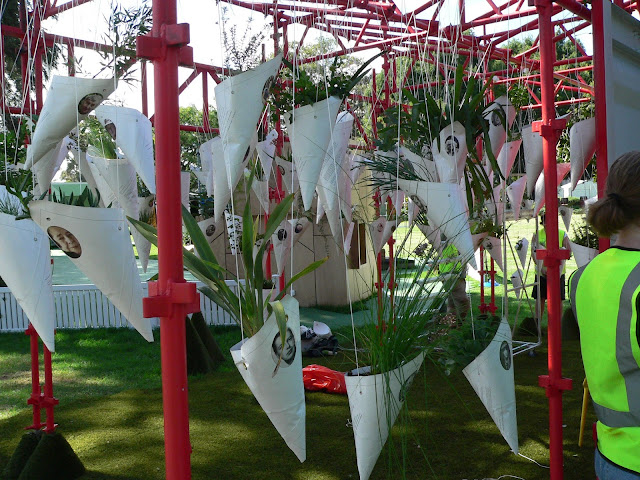Melbourne University Burnley vegetable plot week one (1/3/2016)
History of the plot system for students at Burnley
As part of our subjects for this year we are establishing vegetable plots in the field station at Burnley. The whole idea of having plots to develop and nurture was initiated back in the 1950s after a visit from Miss Frances Miner from the Brooklyn Botanic Gardens. She described a system of individual plots. The idea was implemented at Burnley and sections of the field station (back then a market garden) were transformed into cut flower, tree and also vegetable plots. Students were assessed on their plots and the best ones were awarded prizes (Winzenried 1991). The idea has been continued to this day although I'm not aware of any prizes being awarded. The plots are a great way to provide some hands on gardening experience for students that haven't done much actual gardening.
Plot layout, dimensions and soil composition
The plots were given are 4.2m long by 1.2m wide with the top of the plot (the short edge) facing north east. They all form a grid with walkways of roughly 60cm between them. All plots were raised beds of soil with no sides made of sleepers. We levelled them all down to roughly 15-20cm. The soil in the field station was a welcome contrast to the heavy clay of my home garden in Macedon. It seemed quite sandy and was a dream to work with a spade. The soil itself seemed a little hydrophobic as I noticed some water run off but this was easily worked around by constructing berms (water wells) which helped with the initial watering in of the seedlings.
Crop species
Our lecture Dr Chris Williams chose the crop species. It was always going to be touch and go as to whether some of these plants were going to mature as some of them (eg tomato plants) were being planted out rather late in the season. The timing of the start the semester meant we were growing our plants in more of a transition phase between summer and autumn rather than planting out in spring as one would traditionally do. From south to North we planted out the following seedlings / plants;
- Advanced tomato plants (Grosse Lisse and Roma) with intermingling Genovese basil seedlings as companions.
- Black Beauty zucchini seedling (semi advanced)
- Oregon Sugar snowpea seeds planted around a bamboo tripod
- A row of Brown Beauty bush beans (planted from seed)
- Cos lettuce seedlings
- New Zealand Yam / Oca (delicious if you haven't tried it then give it a go)
- Nantes carrots (by seed)
- Green Dragon broccoli seedlings
- Ruby silverbeet seedlings
Work done during week one
We initially level out or plots down to raised earth beds approximately 15-20cm in height. I then plated out the seeds / seedlings mentioned above and installed a bamboo tripod for the snow peas. I paid careful attention to irrigation as we were working on a day that was to reach 36 degree Celsius! I watered in each hole, planted the seedlings, constructed a berm (water well) around each seedling then watered in the seedlings. I spread dynamic lifter fertiliser on the bed and then mulched the bed with lots of straw (the sown seeds were lightly sprinkled with very fine sugar cane mulch). I mulched the walkways and then irrigated the whole bed very thoroughly.
Worries about irrigation
As I am a part time student I was worried about my plot drying out over the coming week. I only attend Burnley two days per week which meant five days where I couldn't water. The forecast predicted very hot weather. Luckily in my absence a fellow student voluntarily irrigated my plot.
A note on my lecturer for this subject (Plant production and culture)
Dr Chris Williams is particularly interested in edible plant culture, public open space issues and also in combining the two in the form of edible landscapes . He writes his own blog on such subjects. If you are interested the address is
http://peopleplantslandscapes.blogspot.com.au
The field in 1894 when it was a market garden (Winzenried 1991).
Women attending crops in 1900 in somewhat impractical attire. Women were allowed to train at Burnley starting in 1899 which I believe was a quite progressive decision during that period of Australia's history (Winzenried 1991).
Seedling being planted out at an unknown date (Winzenried 1991).
Class of 1950 students in what I assume could have possibly been the first student plots (Winzenried 1991).
Student plots in 1965 (Winzenried 1991).
Student plots in 1980 (Winzenried 1991).
Overview of the area for our plots
Plots as furrows.
My levelled bed with spacing marked out and a few plants in the ground.
My plot all planted out and mulched.
References
Winzenried A.P. (1991) Green Grows Our Garden: A centenary history of horticultural education at Burnley, Hyland House Publishing Pty Limited, Melbourne.
Williams C. (2016) Lecture notes plant production and culture, University of Melbourne, Burnley.
































